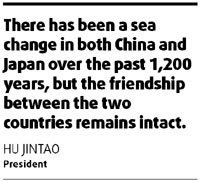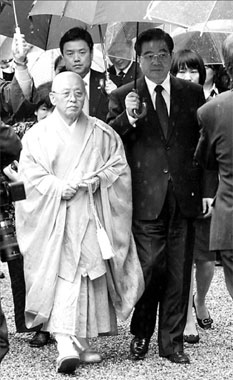Ancient city a testament to close ties between neighbors
By Chong Zi and Qin Jize (China Daily)
Updated: 2008-05-12 07:16
Updated: 2008-05-12 07:16
NARA, Japan: A visit to an ancient Japanese temple with strong historic links to China wound up President Hu Jintao's five-day state visit.
In gentle, steady rain, Hu visited Horyuji and Toshidai-ji, two Buddhist temples in Nara City - reminiscent of Japanese Prime Minister Yasuo Fukuda's visit last year to Qufu, home of Confucius, in search of traces of Chinese influence on Japan.

Nara City - the first permanent Japanese capital which was built in 710 - and the two temples are a showcase of active exchanges between China and Japan in ancient times.
Hu paid homage to the statue and tomb of Chinese Buddhist monk Jianzhen (AD 688-763) - Ganji in Japanese - who built Toshidai-ji Temple in 759. After five earlier trips, Jianzhen was invited by the Japanese emperor in AD 754 to introduce correct monastic rules and establish an authentic ordination platform.
"It is amazing that you have kept the 1,200-year-old temple in such good shape," Hu, impressed by its grandeur, told the Toshidai-ji's Resident Priest Shunkai Matsuura. He gave the temple a replica of the ship Jianzhen sailed from Yangzhou, in Jiangsu, to Nara.
During his nine years in Japan, Jianzhen not only preached Buddism but, along with his disciples, also imparted his knowledge of Chinese medicine, language, literature, architecture, sculpture, calligraphy and printing.
|
President Hu Jintao is escorted by Resident Priest Shunkai Matsuura as he visits the Toshidai-ji temple in Nara, western Japan, on Saturday. Reuters |
Japan honors him as the patriarch of sugar extraction, sewing, bean curd making and soy sauce production. He was posthumously called the Great Teacher Kaikai, or the Great Teacher Who Crossed the Sea. He did not return to his homeland and died in Toshidai-ji Temple.
"Today is a historically important day," Shogo Arai, governor of Nara Prefecture, said.
"There has been a sea change in both China and Japan over the past 1,200 years, but the friendship between the two countries remains intact," Hu said.
This was Hu's second visit to Nara - a Chinese youth delegation led by him toured the city in 1985, and its historical glory impressed him.
Nara was a carefully planned city, modeled after Chang'an (now Xi'an), capital of China's Tang Dynasty. The culture of the imperial court in Nara was heavily influenced by China.
"It showcases the long-lasting relationship between China and Japan," Hu said when visiting the Horyuji temple.
The Nara court aggressively introduced Chinese civilization by regularly sending diplomatic envoys to the Tang court. Many Japanese students, both lay and Buddhist priests, studied in Chang'an and Luoyang.
The Japanese students - called Kentoshi in their country - learnt the language, calligraphy, painting, architecture, sculpture, wrestling, polo, and Buddhist scripts, and borrowed from what were then the most advanced political and legal systems.
"Both Nara City and the two temples are the symbols of the cultural exchanges between China and Japan," Hu told Arai and Japanese Minister of Land, Infrastructure and Transport Tetsuzo Fuyushiba, who accompanied him during his Nara trip.
Hu said he hoped that the Chinese and the Japanese will continue the exchanges and work harder to promote the friendship between the two countries.
(China Daily 05/12/2008 page2)
|
||
|
||
|
|
|
|
